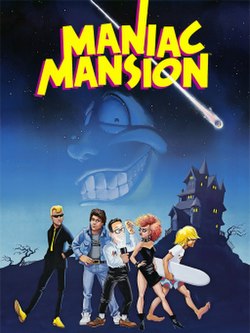Maniac Mansion
| Maniac Mansion | |
|---|---|

Ken Macklin's cover artwork depicts five of the playable characters: Syd, Dave, Bernard, Razor, and Jeff.
|
|
| Developer(s) |
|
| Publisher(s) |
Lucasfilm Games
|
| Director(s) | Ron Gilbert |
| Designer(s) |
Ron Gilbert Gary Winnick |
| Artist(s) | Gary Winnick |
| Composer(s) |
Chris Grigg
David Lawrence
|
| Engine | SCUMM |
| Platform(s) | Commodore 64, Apple II, IBM PC, Amiga, Atari ST, Nintendo Entertainment System |
| Release date(s) | |
| Genre(s) | Graphic adventure |
| Mode(s) | Single-player |
| Review scores | |
|---|---|
| Publication | Score |
| Eurogamer | 9/10 |
| ACE | 820 out of 1000 |
| Zzap!64 | 93% |
| The One | 83% |
| Commodore User | 8/10 |
| Amiga Format | 73% |
| The Games Machine | 76% |
| Mean Machines | 89% |
Maniac Mansion is a 1987 graphic adventure video game developed and published by Lucasfilm Games. It follows teenage protagonist Dave Miller as he attempts to rescue his girlfriend from a mad scientist, whose mind has been enslaved by a sentient meteor. The player uses a point-and-click interface to guide Dave and two of his six playable friends through the scientist's mansion while solving puzzles and avoiding dangers. Gameplay is non-linear, and the game must be completed in different ways based on the player's choice of characters. Initially released for the Commodore 64 and Apple II, Maniac Mansion was Lucasfilm Games' first self-published product.
The game was conceived in 1985 by Ron Gilbert and Gary Winnick, who sought to tell a comedic story based on horror film and B-movie clichés. They mapped out the project as a paper-and-pencil game before coding commenced. While earlier adventure titles had relied on command lines, Gilbert disliked such systems, and he developed Maniac Mansion's simpler point-and-click interface as a replacement. To speed up production, he created a game engine called SCUMM, which was used in many later LucasArts titles. After its release, Maniac Mansion was ported to several platforms. A port for the Nintendo Entertainment System had to be reworked heavily, in response to complaints by Nintendo of America that the game was inappropriate for children.
...
Wikipedia
